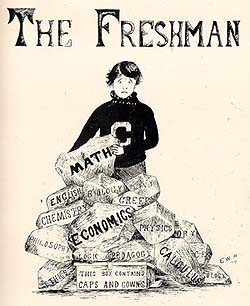The mathematics curriculum responded to both internal factors (e.g. department expertise, college requirements) and external factors (e.g. textbook trends, demand for teachers and engineers). Although the evolution was almost continuous, the following divisions reflect some of the key periods in the changing curriculum.
 |
- Early Years of the College (1874 - 1900)
Early students take algebra, geometry, and trigonometry.
- Cajori Period (1901 - 1918)
Majors introduced; Complete list of elective courses.
- Sisam and Lovitt Influence (1919 - 1932)
Detailed requirements; Complex analysis and statistics added.
- The New College Plan (1933 - 1946)
Disciplines divided into Schools; No formal requirements.
- Post War Years (1947 - 1959)
Abstract Algebra introduced; Curriculum becomes streamlined.
- The Sixties (1960-1969)
Curriculum expands again; Computing courses added.
- Early Block Plan Years (1970 - 1985)
Several flavors of calculus; Number theory becomes central.
- End of the Century (1986 - 1999)
Two major curriculum revisions; Departmental review.
|
| Image from the 1904 Pikes Peak Nugget |
|



